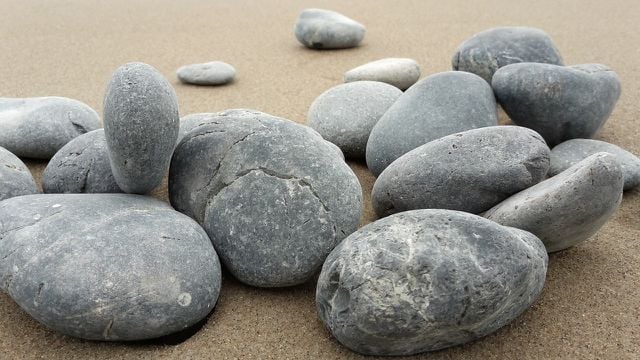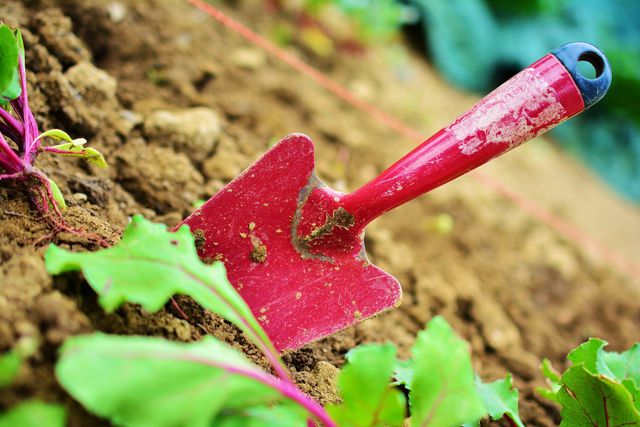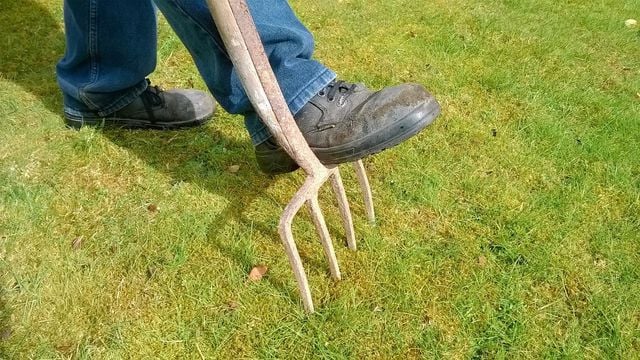
With primary rock flour you can fertilize your garden naturally with minerals. Here you can find out where the fertilizer comes from and how to use it properly.
Plants also need minerals like magnesium, iron, potassium and calcium. Primal rock meal contains many of these nutrients – it’s a traditional, natural mineral fertilizer.
Don’t confuse: Mineral fertilizer is often equated with artificial fertilizer. But man-made fertilizer contains minerals only through sometimes complex chemical processes.
The mineral fertilizer rock flour, on the other hand, contains natural nutrients. It consists of stones ground to dust. Primary rock flour is mainly based on fossilized lava such as basalt or the lesser-known diabase. The rocks originate from prehistoric volcanic eruptions. This is why rock flour bears the prefix “Ur” – for “primeval.”
About 20 to 30 million years ago, there were still active volcanoes in large parts of what is now Europe. The volcanic Eifel near the Belgian border, for example, still bears witness to the volcanic prehistory of our region. The fossilized lava contains minerals from the earth’s interior that were brought to the surface by volcanic eruptions.
Rock flour is also available from other stones such as quartz, zeolite or even granite. Unlike the aforementioned lava stones, these stones contain fewer nutrients for plants, but prepare the soil. With the very porous zeolite, which consists of aluminum and silicon, you loosen for example firm loamy soils.
Often these rock meals do not have the prefix Ur- in their name, although these stones were also formed several 100 million years ago. The name “rock flour”, whether with or without Ur-, is not protected. It is best to check the manufacturer’s specifications to see which stones have been ground and which minerals are included.
Contents
- 1 Original rock flour is full of valuable minerals
- 2 Rock flour: when you need it and how it works
- 3 Rock flour: how to apply the fertilizer
- 4 1 use rock flour dry:
- 5 2 use primary rock flour wet:
- 6 3 other possibilities how you fertilize with primary rock flour:
- 7 Powdered primary rock: better than artificial fertilizer?
- 8 Greenpeace reports on the climate-damaging effects of artificial mineral fertilizer containing nitrogen.
- 9 Author
Original rock flour is full of valuable minerals

Lava stones are mostly black to gray, so the ground primary rock powder has a similar color. Its chemical composition is identical to that of the stones from which it was ground.
The primary rock flour provides your vegetable patch with the necessary minerals that plants need to absorb from the soil through their roots. The package or the manufacturer’s data sheet will tell you exactly which minerals and trace elements are included.
Plants need magnesium to be able to form leaf green. Without magnesium, plants cannot process vitamins, carbohydrates or proteins.
Iron is also involved in photosynthesis in leafy greens.
Potassium and calcium, among other things, ensure that the plant can absorb and transport water.
In most cases, silicic acid (silicon) and traces of other metals are also present, which plants need to grow better.
If the plant lacks these minerals, you can recognize this by yellowish spots on the leaves. The leaves droop and the plant does not grow properly.
Also, you can read on the package of primary rock flour its chemical pH. Depending on how much calcium the fertilizer contains, it will be more or less alkaline (basic). Most fruits and vegetables grow best when the soil is neutral or slightly alkaline, meaning it has a pH of 6.0 to 7.5. You can regulate the natural pH of the soil somewhat with the primary rock flour.
Rock flour: when you need it and how it works

The soil basically consists of weathered stones and thus already contains all the minerals for the plants. But depending on the type and composition of the soil, the amount of minerals it contains varies.
Sandy soils, such as heath, contain little natural magnesium. In addition, rainwater washes out many of the nutrients from the upper layers of soil. Primeval rock flour can add nutrients to the soil.
You can neutralize an acidic garden soil, such as bog soil, somewhat with alkaline primary rock flour. Because on a boggy soil grow beautiful shrubs like rhododendron, but hardly any vegetables. You may also need to add lime, for example algae lime.
Some vegetables, such as tomatoes, require a particularly large amount of nutrients and thus deplete the soil. Therefore, experts refer to such species as heavy eaters. If you use your garden or balcony garden intensively and grow a lot of fruit and vegetables, the soil is depleted more quickly and needs fertilizer again.
Humus content: The minerals in the primary rock flour promote soil bacteria and fungal spores in the soil, which improve the humus content. The soil becomes looser when it contains more humus. It can also store water better.
You can also use primary rock flour in this way:
Compost: When you mix it into compost, the primary rock flour helps decompose the organic materials. The compost will break down faster and is rich in minerals.
Pest Control: Sprinkle the leaves and soil around plants with the primary rock flour. The dusty flour forms a natural barrier against slugs and caterpillars. The animals lose their appetite for your vegetables, but are not killed.
Rock flour: how to apply the fertilizer

You can use the primary rock flour dry or wet.
1 use rock flour dry:
Pick a windless day in late fall or in spring right after the snow melts for your project. Also, the soil should be properly moist so the fine fertilizer doesn’t blow away.
Sprinkle the beds with primary rock flour.
Work the flour flat into the soil with a hoe afterwards. The primary rock flour should be covered with about three to five centimeters of soil – it is therefore in the zone where the roots of the young plants will later grow.
Caution: If you spread the fine flour dry, it is a very dusty affair. You should therefore wear a mouth guard.
2 use primary rock flour wet:
It is less dusty if you prepare a liquid manure, for example, a nettle liquid manure or from horsetail.
Cut off fresh shoots of nettles or horsetails in spring.
Place the shoots in a bucket and fill it with water.
After about two weeks, the plant cuttings will have fermented and a brown broth will have formed.
Now dispose of the plant cuttings in the compost and stir the primary rock flour into the remaining slurry.
Water the beds extensively with this natural liquid fertilizer using a watering can and shower head.
When the first leaves appear, dilute the fertilizer again with the water.
Another advantage: the primary rock flour binds the smell of the plant slurry somewhat.
3 other possibilities how you fertilize with primary rock flour:
Vegetables: put some primary rock flour directly into the plant row when you plant beans as well as peas or sow carrots.
Soft fruit: Sprinkle some fertilizer on the roots of the bushes. For strawberries, you can put the flour directly on the plants and under the leaves.
You can also provide minerals to fruit trees or your herb patch this way.
Lawn: Your lawn will grow better and stay green if you fertilize it in spring with a mixture of lime and primary rock flour.
Here is what you should consider when using rock flour
Dosage: How much rock flour you should use depends on the soil structure and what minerals are already present. As a rule of thumb, the more sand your soil contains, the more fertilizer it needs.
In addition to the composition, there are also dosage instructions on the package.
One manufacturer recommends 100 grams per ten liters of soil. Of course, this figure varies up or down depending on the nutrient content of the soil. For a lean, sandy soil, you should use more primary rock flour.
Shelf life: Rock flour does not spoil, just store it in a dry place. You can just use up the leftovers the next year.
Buying: You can get primal rock flour at garden supply stores or agricultural supply stores. The packages usually contain between five and 25 kilograms.
Powdered primary rock: better than artificial fertilizer?
Primary rock flour from lava stones is a natural mineral fertilizer approved for organic farming. This is what Demeter calls primary rock flour as a mineral fertilizer in their guidelines for organic fertilization.
The stones for the primary rock flour mostly come locally from Europe and thus have relatively short transport distances. In quarries, mainly in southern Europe, basalt or other lava stones are extracted in opencast mining.
However, a quarry also means an intervention in nature. The soil, which has to give way, cannot be recreated in this way. Thus, primary rock flour is a natural fertilizer, but not a sustainable one.
However, artificial mineral fertilizer is also problematic: Many types consist of more or less elaborately processed mineral salts and nitrogen.
Manufacturers also extract the minerals in mining operations. For example, magnesium salt for fertilizer granules is mined underground and further processed.
The nitrogen in the fertilizer is critical for climate protection. The chemical process used to produce it is very energy-intensive. The Encyclopedia of Chemistry explains that nitrogen fertilizer accounts for around one percent of global energy consumption. Some of this energy comes from coal-fired power plants, which emit particulate matter and harm the climate.
Greenpeace reports on the climate-damaging effects of artificial mineral fertilizer containing nitrogen.
The “overfertilization” of the fields leads to the fertilizer entering the water cycle. There, the oxygen in the water can combine with the nitrogen to form nitrate. It also stimulates the growth of algae. In these waters, fish and aquatic animals have hardly any oxygen left to breathe.
The artificial nitrogen fertilizer releases nitrous oxide, one of the greenhouse gases that are harmful to the climate. This can already escape into the atmosphere during production.
If you use rock flour carefully, this mineral fertilizer is better for the environment than artificial fertilizer. You can cultivate your garden even more sustainably if you add the nutrients to the soil via composted garden waste.
Nitrogen, for example, is contained in every plant. With compost or mulch, you naturally fertilize your beds with many valuable nutrients. If you don’t have the option of composting, horn shavings are an alternative to nitrogen fertilizer.
If you already have a good, lo
ose humus soil, you can fertilize individual beds with primary rock flour. In this way you can use this fertilizer sparingly.
Tip: Maybe only add a part of your compost with primary rock flour. You can use this “special compost” for strong plants – for example, in the tomato bed.

